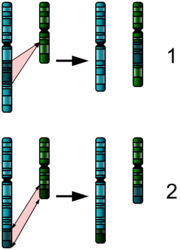Chromosome numbers in other organisms | Species | Large
Chromosomes | Intermediate
Chromosomes | Small
Chromosomes | | Trypanosoma brucei | 11 | 6 | ~100 |
 The 24 human chromosome territories during prometaphase in fibroblast cells. Normal members of a particular eukaryotic species all have the same number of nuclear chromosomes (see the table). Other eukaryotic chromosomes, i.e., mitochondrial and plasmid-like small chromosomes, are much more variable in number, and there may be thousands of copies per cell. Asexually reproducing species have one set of chromosomes, which is the same in all body cells. Sexually reproducing species have somatic cells (body cells), which are diploid [2n] having two sets of chromosomes, one from the mother and one from the father. Gametes, reproductive cells, are haploid [n]: they have one set of chromosomes. Gametes are produced by meiosis of a diploid germ line cell. During meiosis, the matching chromosomes of father and mother can exchange small parts of themselves (crossover), and thus create new chromosomes that are not inherited solely from either parent. When a male and a female gamete merge (fertilization), a new diploid organism is formed. Some animal and plant species are polyploid [Xn]: they have more than two sets of homologous chromosomes. Agriculturally important plants such as tobacco or wheat are often polyploid compared to their ancestral species. Wheat has a haploid number of seven chromosomes, still seen in some cultivars as well as the wild progenitors. The more common pasta and bread wheats are polyploid, having 28 (tetraploid) and 42 (hexaploid) chromosomes compared to the 14 (diploid) chromosomes in the wild wheat.[20] Prokaryotes Prokaryote species generally have one copy of each major chromosome, but most cells can easily survive with multiple copies.[21] Plasmids and plasmid-like small chromosomes are, like in eukaryotes, very variable in copy number. The number of plasmids in the cell is almost entirely determined by the rate of division of the plasmid - fast division causes high copy number, and vice versa. Karyotype  Figure 3: Karyogram of a human male In general, the karyotype is the characteristic chromosome complement of a eukaryote species.[22] The preparation and study of karyotypes is part of cytogenetics. Although the replication and transcription of DNA is highly standardized in eukaryotes, the same cannot be said for their karotypes, which are often highly variable. There may be variation between species in chromosome number and in detailed organization. In some cases there is significant variation within species. Often there is variation 1. between the two sexes. 2. between the germ-line and soma (between gametes and the rest of the body). 3. between members of a population, due to balanced genetic polymorphism. 4. geographical variation between races. 5. mosaics or otherwise abnormal individuals. Finally, variation in karyotype may occur during development from the fertilised egg. The technique of determining the karyotype is usually called karyotyping. Cells can be locked part-way through division (in metaphase) in vitro (in a reaction vial) with colchicine. These cells are then stained, photographed and arranged into a karyogram, with the set of chromosomes arranged, autosomes in order of length, and sex chromosomes (here XY) at the end: Fig. 3. Like many sexually reproducing species, humans have special gonosomes (sex chromosomes, in contrast to autosomes). These are XX in females and XY in males. Historical note Investigation into the human karyotype took many years to settle the most basic question: how many chromosomes does a normal diploid human cell contain? In 1912, Hans von Winiwarter reported 47 chromosomes in spermatogonia and 48 in oogonia, concluding an XX/XO sex determination mechanism.[23] Painter in 1922 was not certain whether the diploid number of man was 46 or 48, at first favouring 46.[24] He revised his opinion later from 46 to 48, and he correctly insisted on man having an XX/XY system.[25] Considering their techniques, these results were quite remarkable. New techniques were needed to definitively solve the problem: - 1. Using cells in culture 2. Pretreating cells in a hypotonic solution, which swells them and spreads the chromosomes 3. Arresting mitosis in metaphase by a solution of colchicine 4. Squashing the preparation on the slide forcing the chromosomes into a single plane 4. Cutting up a photomicrograph and arranging the result into an indisputable karyogram.
It took until the mid 1950s until it became generally accepted that the karyotype of man included only 46 chromosomes.[26][27] Rather interestingly, the great apes have 48 chromosomes. | 





